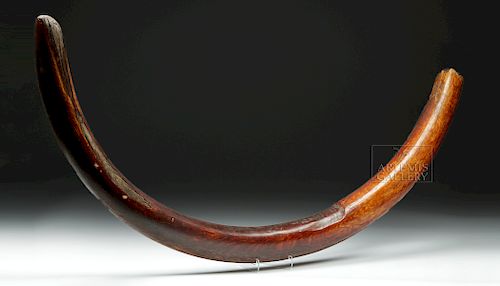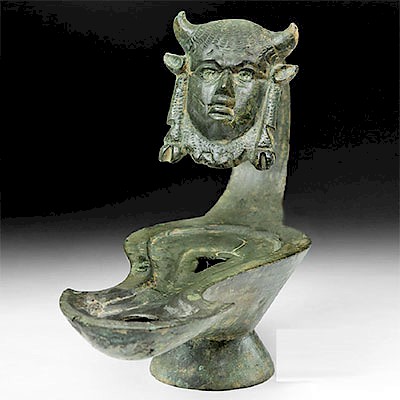Massive Ice Age Mammoth Tusk - Growth Marks
Lot 116k
About Seller
Artemis Fine Arts
686 S Taylor Ave, Ste 106
Louisville, CO 80027
United States
Selling antiquities, ancient and ethnographic art online since 1993, Artemis Gallery specializes in Classical Antiquities (Egyptian, Greek, Roman, Near Eastern), Asian, Pre-Columbian, African / Tribal / Oceanographic art. Our extensive inventory includes pottery, stone, metal, wood, glass and textil...Read more
Estimate:
$8,000 - $10,000
Absentee vs Live bid
Two ways to bid:
- Leave a max absentee bid and the platform will bid on your behalf up to your maximum bid during the live auction.
- Bid live during the auction and your bids will be submitted real-time to the auctioneer.
Bid Increments
| Price | Bid Increment |
|---|---|
| $0 | $25 |
| $300 | $50 |
| $1,000 | $100 |
| $2,000 | $250 |
| $5,000 | $500 |
| $10,000 | $1,000 |
| $20,000 | $2,500 |
| $50,000 | $5,000 |
| $100,000 | $10,000 |
| $200,000 | $20,000 |
About Auction
By Artemis Fine Arts
Sep 27, 2018
Set Reminder
2018-09-27 10:00:00
2018-09-27 10:00:00
America/New_York
Bidsquare
Bidsquare : Antiquities | Asian | Ethnographic
https://www.bidsquare.com/auctions/artemis-gallery/antiquities-asian-ethnographic-3469
Featuring classical antiquities, ancient and ethnographic art from cultures encompassing the globe. Artemis Fine Arts info@artemisgallery.com
Featuring classical antiquities, ancient and ethnographic art from cultures encompassing the globe. Artemis Fine Arts info@artemisgallery.com
- Lot Description
Arctic region, Pleistocene epoch (Ice Age), ca. 35,000 years ago. A massive fossilized mammoth tusk of rich coppery hues, with a notable ring about one third of the way up its length, as if the animal experienced a period of injury or starvation that left a mark in the growth of its tusk. Size: 2.7" W x 43" H (6.9 cm x 109.2 cm)
Imagine walking in a modern Arctic or sub-Arctic landscape like Alaska, northern Canada, or Siberia and finding a tusk like this rising from the ground - the name mammoth comes from a Siberian word used to describe the tusks found there by native people, like the Khanty of the Irtysh River basin, and traded to Europe and China. Their occasional finds of massive tusks and even preserved mammoth bodies in the permafrost - often eroding out of the sides of river banks - led to their folkloric belief that mammoths were like huge rodents, dwelling underground, dying when they accidentally surfaced. With the invention of science as a discipline, massive tusks like this one continued to capture imaginations all over the world - for example, Thomas Jefferson, who was fascinated by paleontology, is credited with introducing the use of the word mammoth as an adjective to describe something very large.
Please note that fossilized ivory tusks from any species cannot be shipped to the US States of California, Hawaii, Nevada, New Hampshire, New Jersey, New York, Oregon, and Washington State. As of 2019, they will not be able to be shipped to Illinois.
Provenance:
All items legal to buy/sell under U.S. Statute covering cultural patrimony Code 2600, CHAPTER 14, and are guaranteed to be as described or your money back.
A Certificate of Authenticity will accompany all winning bids.
We ship worldwide and handle all shipping in-house for your convenience.
#135228Small losses to enamel surface, with most wear at tip. Tiny losses around the end.Condition
- Shipping Info
-
All shipping is handled in-house for your convenience. Your invoice from Artemis Gallery will include shipping calculation instructions. If in doubt, please inquire BEFORE bidding for estimated shipping costs for individual items.
-
- Buyer's Premium



 EUR
EUR CAD
CAD AUD
AUD GBP
GBP MXN
MXN HKD
HKD CNY
CNY MYR
MYR SEK
SEK SGD
SGD CHF
CHF THB
THB














